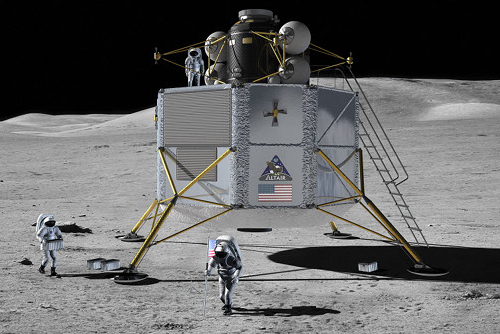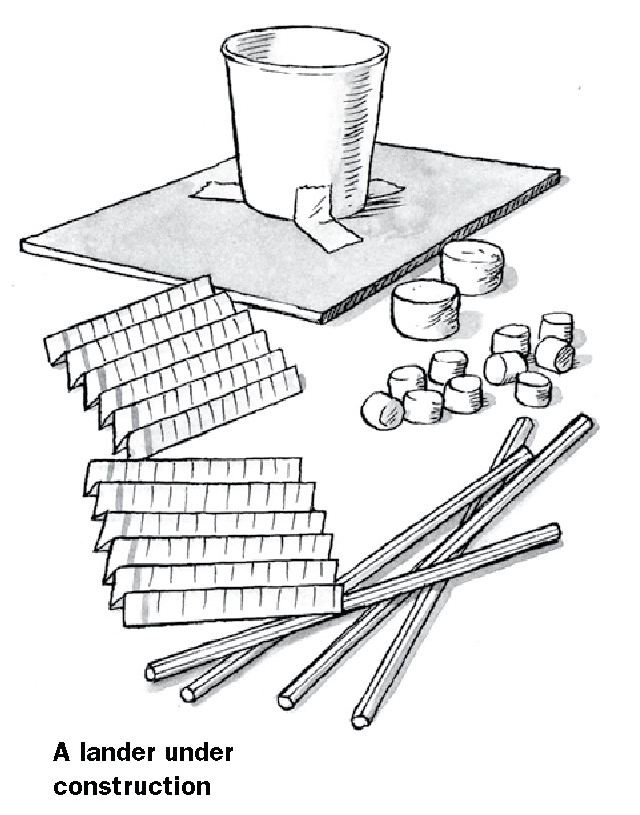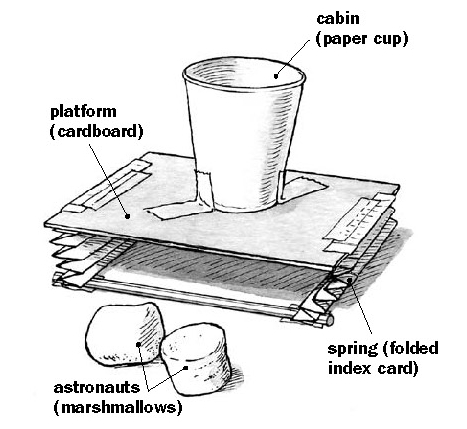Lesson: Build a Lunar Lander
 (Lesson courtesy NASA and Design Squad, drawn from the On the Moon Educator Guide) Level: Students in grades 3-8. Group Size: 3-4.
(Lesson courtesy NASA and Design Squad, drawn from the On the Moon Educator Guide) Level: Students in grades 3-8. Group Size: 3-4.
Touchdown: The Lunar Lander Challenge
In this lesson, students assume the role of NASA aerospace engineers, using the engineering design process to learn steps for designing, creating, and improving equipment. They design and build a shock-absorbing system that protect two marshmallow “astronauts” when they land. By doing so, they come to understand some of the challenges of lunar landings.
Students perform the following:
1. Design and build a shock-absorbing system out of paper, straws, and mini-marshmallows.
2. Attach their shock absorber to a cardboard platform.
3. Use test results to improve their design.
National Science Education Standards (Grades 3–8)
Physical Science
- Properties of Objects and Materials (K–4)
- Position and Motion of Objects (K–4)
- Motion and Forces (5–8)
Science and Technology
- Abilities of Technological Design (3–8)
- Understandings About Science and Technology (3–8)
International Technology Education Association Content Standards (Grades 3–8)
Design
- Standard 2: Students will develop an understanding of the core concepts of technology.
- Standard 8: Students will develop an understanding of the attributes of design.
- Standard 9: Students will develop an understanding of engineering design.
- Standard 10: Students will develop an understanding of the role of troubleshooting, research and development, invention and innovation, and experimentation in problem solving.
Abilities for a Technological World
- Standard 11: Students will develop abilities to apply the design process.
- Standard 12: Students will develop abilities to use and maintain technological products and systems.
The Designed World
- Standard 16: Students will develop an understanding of and be able to select and use energy and power technologies.
Massachusetts Science and Technology/Engineering Standards (Grades 3–8)
Physics (3–8)
- Observable Properties of Objects
- Position and Motion of Objects
- Properties of Objects and Materials
- Forms of Energy
Technology/Engineering (3–8)
- Materials and Tools
- Engineering Design
National Council of Teachers of Mathematics Standards (Grades 3–8)
Problem Solving
- Build new mathematical knowledge through problem solving
- Solve problems that arise in mathematics and in other contexts
- Apply and adapt a variety of appropriate strategies to solve problems
Measurement
- Understand measurable attributes of objects and units, systems, and processes of measurement
- Apply appropriate techniques, tools, and formulas to determine measurements
Vocabulary and Concepts
Potential and kinetic energy—When the lander hits the surface, its motion (kinetic) energy is changed into stored (potential) energy, which gets stored in the shock absorbers.
Acceleration due to gravity—The lander accelerates (speeds up) as it falls due to Earth’s gravitational pull.
Air resistance—Air exerts a force on the lander as it falls, slowing it down. Measurement—Kids measure the various heights from which they drop the lander.
 Materials
Materials
- Full Touchdown Activity (pdf) for teacher reference
- Touchdown Challenge Sheets for students
- The Design Process Sheet (optional)
(per lander)
- 1 piece of stiff paper or cardboard (approximately 4 x 5 in/10 x 13 cm)
- 1 small paper or plastic cup
- 3 index cards (3 x 5 in/8 x 13 cm)
- 2 regular marshmallows
- 10 miniature marshmallows
- 3 rubber bands
- 8 plastic straws
- scissors
- tape
Preparation
1. Read the challenge sheet and leader notes to become familiar with the activity.
2. Gather the materials listed on the challenge sheet.
3. Fold an index card into a spring for demonstration with students (see illustration above).
4. Clear a space in the classroom for the touchdown tests.
Introduce the challenge (5 minutes)
1. Explain to students why a spacecraft that can land gently is important for getting astronauts to and from the moon safely:
(From the Challenge Sheet) Landing on the moon is tricky. First, since a spacecraft can go as fast as 18,000 miles per hour (29,000 km/hour) on its way to the moon, it needs to slow way down. Then it needs to land gently. That lander has astronauts inside, not crash-test dummies.
NASA is looking for safe landing sites on the moon. Once they find one, they need to design and build a spacecraft that can land there without injuring astronauts or damaging the spacecraft.
Today you’ll make a lander—a spacecraft that can land safely when you drop it on the floor of the moon–or classroom. As you test your constructed lander, you’ll find ways to make it work better. Improving a design based on testing is an important part of the engineering design process. For the design process, we: 1) identify the problem or challenge; 2) brainstorm solutions; 3) design your equipment or device; 4) build it; 5) test and evaluate the outcome; 6) discuss your solutions; and then 7) make improvements for better performance. (Teachers may wish to distribute the Design Process Sheet)
2. Demonstrate a spring made out of an index card.
When you jump off a high step, you bend your back and knees to absorb some of the energy and break your fall. That’s what a shock absorber does—absorbs the energy of an impact. Soft things, like marshmallows, cotton balls, foam, and bubble wrap absorb shock well. You can also use paper, like this index card made into a spring by folding it like an accordion.
3. Divide the class into small groups and distribute the materials
Explain the function of the 2 regular marshmallows (astronauts), cardboard (platform), and small cup (cabin)
Brainstorm and design (10 minutes)
Distribute the Challenge Sheet. Discuss the questions in the Brainstorm and Design section.
- What kind of shock absorber can you make from these materials to help soften a landing? (Mini-marshmallows can serve as soft footpads. Cards can be folded into springs. Straws can provide a flexible structure. Rubber bands can flex and hold things together.)
- How will you make sure the lander doesn’t tip over as it falls through the air? (Making the parts below the platform weigh more than the parts on the top helps the lander fall straight down. Also, it helps to evenly distribute the weight on top of the platform.)
Build, test, evaluate, and redesign (35 minutes)
BUILD: Instructions for students from the Challenge Sheet.
1. First, design a shock-absorbing system from the supplied materials.
Think springs and cushions.
2. Then, put your spacecraft together.
Attach the shock absorbers to the cardboard platform.
3. Finally, add a cabin for the astronauts.
Tape the cup to the platform. Put two astronauts (the large marshmallows) in it. (NOTE: The cup has to stay open—no lids!)
TEST: Instructions to students from the Challenge Sheet.
Ready to test? Drop your lander from a height of one foot (30 cm). *Note: Teachers may direct students to test their landers in their individual groups. Or, in a smaller class, each group can demonstrate before the class, while the other students watch and make notes about the different design solutions and outcomes.
EVALUATE AND REDESIGN: Instructions to students from the Challenge Sheet.
If the “astronauts” bounce out, figure out ways to improve your design. Study any problems and redesign.
For example, if your spacecraft:
- tips over as it falls through the air—Make sure it’s level when you release it. Also check that the cup is centered on the cardboard. Finally, check that the weight is evenly distributed.
- bounces the astronauts out of the cup—Add soft pads or change the number or position of the shock absorbers. Also, make the springs less springy so they don’t bounce the astronauts out.
Teachers should assist students with any difficulties they may encounter. For example, if the lander:
- tips over when it drops—Move the cup slightly away from the side that’s tipping. Or, reposition the parts of the shock-absorbing system to better balance the weight.
- bounces instead of landing softly—Change the size, position, or the number of shock-absorbing parts. Kids can also add mini-marshmallows for landing-pad feet. Or, they can use marshmallows at key junctions in the lander’s frame to help absorb energy.
ASSESSMENT (10 minutes)
Have each group of students show the class their landers, explaining their design choices and how they solved the problems they encountered. Emphasize the key ideas in today’s challenge by asking:
- What forces affected your lander as it fell? (It accelerated [sped up] as it fell due to the pull of gravity. Air also pushed on it, and this air resistance slowed it down.)
- After testing, what changes did you make to your lander? (Answers will vary.)
- Engineers’ early ideas rarely work out perfectly. How does testing help them improve a design?
- (Testing helps you see what works and what doesn’t. Knowing this lets you improve a design by fixing the things that aren’t working well or could work even better.)
- What did you learn from watching others test their landers? (Answers will vary. But in general, students will see that there are many ways to successfully tackle a challenge.)
- The moon is covered in a thick layer of fine dust. How might this be an advantage? A disadvantage? (If the dust layer is soft, it would help cushion a landing. However, if it is too soft, a lander could sink into it and get stuck. Also, the lander’s rocket engine could send up clouds of dust, which could get into the machinery and cause it to jam or malfunction.)
Extensions
- Hold a “How High Can You Go?” contest. Have kids drop their landers from two feet. Eliminate all landers that bounce out their “astronauts.” Next, raise the height to three feet. Continue in this fashion until a winner emerges. You can also increase the challenge by having kids add a third marshmallow “astronaut” to their cups.
- Test springs of different sizes. Have kids see if the number of folds in an index card makes a difference in the amount of force the spring can absorb. Have them fold index cards with two, four, and six folds. Have them test to see how much of a difference these different springs make in how softly a lander touches down.
- Older students can be challenged to research about lunar landers, and then report back on techniques being developed by NASA for more effective landers, such as the Altair, being developed at the Marshall Space Flight Center.
Curriculum Connections
The Touchdown Lesson and Activity involves concepts commonly covered in science, math, and technology curricula. Please consult NASA’s On the Moon Educator Guide, from which this lesson is drawn, to find more material on engineering and the engineering design process; NASA’s lunar exploration and planned habitation; the lunar reconnaissance orbiter (LRO) and Lunar Crater Observation and Sensing Satellite (LCROSS), additional activities, and helpful teacher tips.
Image credit: NASA, Artist’s rendering of three crew members in the area of their lunar lander on the lunar surface. Please note that this artwork is not precise: NASA currently is seeking input from industry experts and is developing conceptual designs for the lunar lander Altair.
Filed under: Grades 6-8, Grades K-5, Lesson Plans
Tags: Aerospace, Aerospace Engineering, Engineering Design Process, Grades 3-8, NASA









